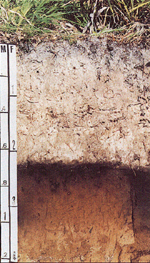The following series of columns entitled ‘Soil to Sky’ are an examination of five different facets of environment, structure, and life that are instrumental to trees in our forests and landscapes. Trees are instrumental to our wellbeing, both individually and collectively as a society. Healthy urban forests and natural areas are the responsibility of professional arborists, policy-makers, volunteers and individuals, among others. We will be sharing our enthusiasm with you in weekly installments and encourage you to become tree stewards, heralding forth the future of healthy trees.
Soil to Sky
Held to earth
Grasping at clouds
Forever stationed
Never still
Witness the ever-changing world
Beckoned on by nature
Cycle like dreams
Born again
Embryos soundly slept
Covered in decaying warmth
Tickled by hyphal fingers
Dark until emerged
Green hues delicate
Slowly hewn
Become giants
Soil by David Outerbridge
Many of our fondest childhood recollections begin or end caked in mud, soil, leaves, or a combination of all three. Dark lines of soil hidden beneath our fingernails after having our hands in the earth. The soil beneath our feet is more than just dirt or individual grains of simple crumbled rock and detritus. It is a living, breathing organism and ecosystem that regenerates and feeds the world above and encapsulates the delicate balance of life. In Florida alone there are over 300 distinct types of soil that have differing characteristics based on how their profiles are evaluated. These careful examinations of soil scientists form a patchwork quilt over our natural landscapes, and we can see that this idea we have of dirt being just dirt is much more subtle and complex than we realize.
To a tree the soil is home, an anchored bed where roots drift in search of meaning and sustenance. The soil defines the ability of the tree to live. When looking for soil to bed down in, the tree asks many questions. What is the pH? What minerals are present? What is the textural composition of the substrate, clay, loam, or sand? What is the hydrological capacity, seasonal high-water table? In short, a tree determines how it can survive once a seed commits to a location. Huddling in the earth either to sprout immediately or suspended in a dormancy phase waiting for the opportune moment to greet the world. Then once established, trees and forests help evolve and shift soils and play a part in adjusting the balance of the soil to create a more ideal atmosphere for their offspring or an environment that enables them to out compete with other plants. The soil in turn adapts and shifts forming pockets of identity that tell the tales to careful observers.
The soil is home to mycorrhizae, fungi, bacteria, worms, insects, and nematodes that form a complex slow-moving organism that is ever shifting. Forming relationships that can help benefit the trees above by either breaking down or mining nutrients and forming symbiotic relationships underneath the soil to enable the advancement of all collaborators. Fungi, bacteria, worms, and insects utilize the fallen organic matter and break it down to shift the nutrients into simpler structures that are negotiated and exchanged through the root systems of the trees. Some plants dig deep in the soil profile to discover minerals and bring them to the surface. Worms and burrowing animals turn over the soil and allow aeration and water to flow down deeper into the earth.
This foundation for life is extremely important and, in many cases, when looking at problems in our environment and landscapes, looking at the soil first can provide deep insights. During land development the high traffic of machinery and people can compact the soil and prevent plants from growing to their full potential. Plants in new developments can look brilliant at first, fresh from the controlled gentle environment of the plant nursery. However, once they are greeted by the opposition of the firm layer of soil, plants become stunted and there is little dynamic interaction of roots, worms, bugs, and fungi with the soil. Also, planting in areas where there is extreme acidity or alkalinity can cause some plants to react poorly. Knowing one’s soil first can provide key insights into how and what to plant in your environment. Always dig a few holes in the ground before you plant and carefully look at the profile of the ground to see what is going on. Do you find worms? Is there a great deal of organic matter in the upper profile? Do you encounter rocks or a hard packed layer? Take a few samples and send them off to be tested to determine pH, and mineral composition. This foundation of knowledge can help provide the trees in your landscape a good start and enable you to help protect and enrich the unseen world beneath our feet that feeds the world above.
 0
0

